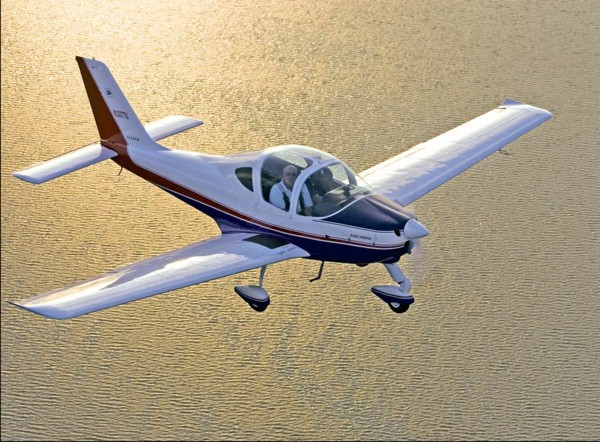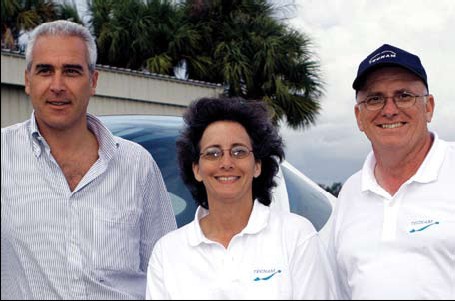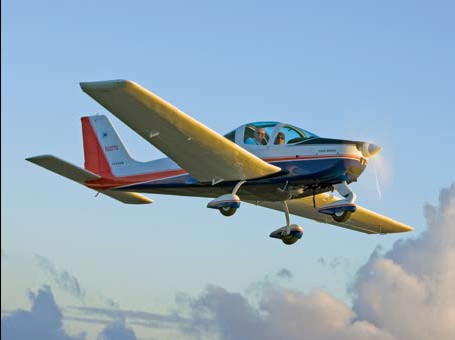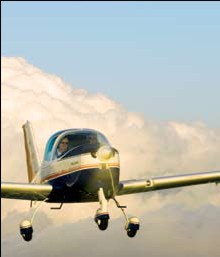

Rounding out Tecnam’s S-LSA offerings in the U.S. are the high-wing Bravo and Echo Super. The Sierra and Bravo use the same laminar flow wing, giving
them similar takeoff characteristics. All three aircraft are tri-gear and all-metal with side-by-side seating.

Left to right, Paolo Pascale, president of Tecnam, and Lynne and Mike Birmingham, Tecnam’s distributor
in the United States, doing business as Tecnam Aircraft based in Marietta, Georgia

The Sierra has dual throttles and joysticks–good for training purposes. Electric
trim is on top of the joystick; trim position is verified by an indicator.

The 100-hp Rotax 912S engine powers all three Tecnams. For IFR flight the
aircraft must be powered by the FAR-33 certified version of the 912S.

Mike Birmingham says the Sierra has a “fighter plane” feel to its handling.
Like the Bravo, the Sierra’s cockpit is 43 inches wide.

Tecnam switched to a tapered wing with a laminar flow to achieve
performance parameters of the United States’ LSA definition.


Before Cessna announced its
light-sport aircraft (LSA) prototype,
the Wichita, Kansas-based
aircraft manufacturer investigated the
airplanes produced by Costruzioni
Aeronautiche Tecnam, aka Tecnam.
Cessna’s interest was likely stimulated
by Tecnam’s 50-year history of
aircraft manufacturing. The company
traces its roots to 1950 and the P48B
Astore. You may also be familiar with
its twin-engine Partenavia series of
aircraft that emerged in the 1970s.
The Pascale brothers founded
Costruzioni Aeronautiche Tecnam
just after World War II, but the company
was reorganized in 1986. Based
today in Casoria, Italy, Tecnam is a
large operation with 36,000 square
feet of facilities near the Naples Capodichino
airport.
A second facility is located
in Capua, where the final assembly
line is adjacent to
an airport where flight tests
are conducted. “Professor”
Luigi Pascale, the 82-yearold
patriarch of Tecnam,
remains the guiding light
of the company. He reportedly
still does all first flights of Tecnam
airplanes. The company’s design approach
is backed with the latest Catia
V5 software, wind tunnel tests, and
close associations with Italian aero
institutes and universities.
You may be wondering how a recreational
aircraft manufacturer can
afford such large facilities, equipped
with many engineering workstations,
extensive machining capability, full
aircraft assembly line, ISO 9002 certification,
and nearly 100 workers on
the production line. The answer is
that Tecnam also builds fuselage sections
for Boeing, horizontal tail plane
assemblies for ATR airliners, and parts
for various other large aircraft.
Of greatest importance to American
sport pilots is the fact this leading
Italian small aircraft manufacturer
has delivered close to 2,000
lightplanes, making it one of the
most prolific producers of fully built
recreational aircraft.
The Italian company definitely
has a rich aviation history, and now
the U.S. market is graced with three
approved special light-sport aircraft
(S-LSA) models from it: the P92 Echo
Super, the P2002 Sierra, and the
P2004 Bravo-the numbers indicating
the year the airplane went into
production. The Sierra also holds
JAR/VLA (Joint Airworthiness Regulations
for Very Light Aircraft) certification.
This European certification
system is a thorough program;
having already complied with those
standards made it relatively easy for
Tecnam to make its Statement of
Compliance as an S-LSA
d
A New Distributor and Modified Designs
Tecnam altered its original approach
to distribution of its products in the
United States about a year ago and appointed
Lynne and Mike Birmingham
as the company’s sole U.S. agents, a
role that requires the Georgia couple
to enlist dealers throughout the country
and initiate the process of import
and distribution of the company’s
airplanes. The Birminghams have established
seven U.S. dealers thus far.
(For a complete listing, visit www.
TecnamAircraft.com and click on Dealers.).
Currently, Tecnam is in a tie for
fourth in the race for market share-
that is, sale and delivery of S-LSA.
Given the accolades heaped on the
flight qualities of Tecnam’s aircraft,
I’d expect the company to maintain
a strong position in the ready-to-fly
LSA market.
My experience with Tecnam aircraft
starts with the company’s
original high-wing P92 Echo, which
evolved into the Bravo and Echo
Super, and the low-wing P96 Golf,
which evolved into the Sierra. (We’ll
look at the Sierra and Bravo in this
report.) Lynne Birmingham reported
the Sierra is substantially changed
from the earlier Golf, but she added
it shares an identical wing with the
cantilever, high-wing Bravo.
The main change made to Echo
Super and Sierra occurred in early
2000 when the squared-off “Hershey
bar” wing then used gave way to a tapered
wing with a laminar flow shape.
Those refinements resulted in a gentler
stall, and the new wing enjoys a
Rounding out Tecnam’s S-LSA offerings in the U.S.
are the high-wing Bravo and Echo Super. The Sierra
and Bravo use the same laminar flow wing, giving
them similar takeoff characteristics. All three aircraft
are tri-gear and all-metal with side-by-side seating.
6- to 8-knot faster cruise speed. While
the older Golf reached 110 knots, the
Sierra can slip along at 116 knots at
75 percent power.
Mike Birmingham, a retired airline
pilot, said the Sierra also takes
turbulence better. “It feels less like a
lightplane and more like a heavier
airplane,” he reported, but he added
it’s also more responsive in roll, not
less as might be expected.
Enhanced longitudinal stability also
resulted from the new wing, Mike said.
“It’s magnificent; the Sierra comes back
to level in three oscillations.” Such a
quality improves cross-country flying,
even for those who choose an autopilot
option. This characteristic also improves
landings by allowing pilots to
flare more precisely thanks to better
stabilator control feel. “You can hold it
off forever,” said Mike.
Some construction changes were
also made to the airplane. The original
Golf had a fabric-covered stabilator
and ailerons, a common choice among
light aircraft designers, but the Sierra
is now an all-metal airplane, including
all control surfaces. The fuselages of
both the high-wing and low-wing Tecnams
also changed. The older models
were oriented toward kit building and
had boxier lines that made assembly
easier for amateurs. The factory-built
Sierra, Echo Super, and Bravo have
smoother, cleaner lines and a more
finished appearance. Other less visible
changes of importance are an integrated
carbon fiber rollover bar and more
rugged landing gear. No change was
made to the nose gear.
Tecnam also advanced the capability
of the airplanes, stretching the
Golf’s 1,160-pound gross weight to
1,320 pounds for the Sierra and increasing the airplane’s fuel capacity
to 26.4 gallons from the Golf’s 18.5
gallons. That translates to another
200 miles of range. Still, despite the
Sierra’s higher gross weight, takeoff
distances between the two airplanes
are similar. However, the Sierra’s laminar
flow wing has to be flown off the
runway, whereas the Golf would practically
fly itself off the ground.
Similar changes occurred in the
transition of the P92 Echo to the
Bravo, which shares the new laminar
flow wing with the Sierra, making
their takeoff characteristics similar.
Mike said the two airplanes perform
fairly similarly. He and Lynne, also
an experienced pilot, compared the
airplanes in side-by-side flights and
found the Bravo just slightly faster.
They speculated that might be related
to the lower amount of dihedral in
the Bravo’s wing. On refueling, the
Birminghams found the two models
had nearly identical fuel burns.
Climb rates were also similar, with
the Sierra being slightly stronger in
en-route climb. The low-wing model
averages 600 fpm at 75 knots. The
older Golf, with its straight and fatter
wing, gets off the ground quicker; its
lighter weight also helps it accelerate
quicker. But Sierra climbs faster and
can fly faster. “It’s the Piper Cherokee
versus Warrior with the wing differences,”
explained Mike. The older
models are superior for getting out of
a short field quicker, he added.
The Bravo’s cabin seems wide, but
the cockpits are actually the same dimension
(43 inches wide), Mike said.
But, balancing the space sensation,
Mike thinks the Sierra has a more
“fighter aircraft” feel, whereas Bravo
will appeal to Cessna lovers. Of course,
the difference in view related to sitting
on the wing spar versus hanging from
it also needs to be considered.
The Bravo offers slightly more
headroom than the Sierra. “Anyone
taller than 6 feet 6 inches will be more
comfortable in the Bravo,” Mike said.
Taller occupants with longer legs will
sit aft more in the Bravo, giving them
more headroom under the spar. Like
most cantilevered designs, the spar
does invade the cockpit to a small degree.
Ironically, a shorter person sitting
farther forward may notice the spar
presence more than a taller person.
The Sierra/Bravo wing has stall
strips that weren’t on the earlier Echo
and Golf models. When Tecnam went
to the laminar flow wing, these wing
devices were added to start the stall inboard.
“A laminar flow wing stalls more
evenly across the surface at once and
stall strips prevent that,” Mike said.
He prefers the high-wing Bravo to
the Sierra for a few reasons: entry and
exit are easier; it is easier to load baggage
into; passengers like to see the
ground more than look up into the
sky; and the high-wing shades the
cockpit, keeping it cooler, a significant
factor for many buyers living in
warmer climates.
The Sierra’s cockpit has dual throttles,
allowing each occupant to have
their left hand on the throttle and
right hand on the joystick. Electric
trim is located on the joystick, and
you can verify the setting via a trim
position indicator.
You can open the Sierra’s cockpit at
any speed, though Mike said it is more
comfortable at speeds under 90 knots.
My experience says even 90 is pretty
windy, but the ultralight enthusiast in
me loved being able to slide the canopy
back. My personal preference also
leans toward high wings-it’s about
the sightseeing view-but opening
the doors isn’t nearly the same as
sliding Sierra’s canopy aft and letting
the breeze flow through. One note:
You cannot have the canopy open for
takeoff according to the pilot’s operating
handbook.
When you latch the canopy of Sierra,
it is quieter than Bravo. “Doors
are harder to seal than a canopy,”
Mike observed. Three latches secure
Sierra’s canopy. When you open the
Sierra’s canopy you’ll suffer a 10-knot
speed penalty, but who cares when
you just want to feel the breeze. Ultralight
pilots and others experienced in
open-cockpit flying love this capability.
When you close the canopy, you
must duck your head a little as the
leading edge is set a bit lower than
the overhead position.
Pilots First
Most pilots who have the chance
to compare many LSA will find the
Tecnam aircraft fly well. The flight
characteristics are no fluke. Mike
reported that Tecnam’s philosophy
is “pilots first, engineers second.”
The controls use no springs; all are
solely aerodynamic in their actions.
To achieve this, all controls are balanced
by well-distributed weights.
Control harmony is good, with pitch
stabilized enough to approximately
match aileron control pressures.
While the Rotax 912 warmed up,
I kept a hand on the center-mounted
brake. Aft of the handbrake lever
is a knob that twists to set the lever.
The brakes are hydraulic; when you
pull the brake lever back and turn the
knob, it locks the hydraulic pressure. Though it may look like a castering
assembly, Sierra has a fully steerable
nose wheel. A rubber doughnut-type
shock absorber takes up most of the
shock you impose on it.
When I set the Sierra’s flaps to 15
degrees for takeoff, I noted the electric
control moves the surfaces quickly,
and you can set infinite positions.
Launching was ordinary and fairly
swift, but you must rotate the airplane
manually. Unlike the Golf, the Sierra
simply won’t fly itself off the tarmac.
Climb settled in at 700-800 fpm.
As we flew around in cruise, I had to
work at not letting Sierra’s nose rise. The
view angle over the nose is such that I
tended to lift the nose too much. Apparently
this is a common reaction by
pilots new to flying this airplane.
The Sierra’s handling is quite responsive
yet very positive. It offers
fluid stick movements, and the rudder
pedals need little action to produce
coordinated turns. Some pilots
accustomed to using equal measures
of stick and rudder may overuse the
rudder initially. I was able to perform
Dutch rolls to 30 to 40 degrees quickly
and without swinging the coordination
ball too wildly. For a short first
flight in the plane, I was satisfied with
my performance of the maneuver.
Many pilots believe the FAA chose
well when it elected to bump the
speed limit for LSA up to 120 knots or
138 mph, and the Sierra makes nearly
full use of this range. Cruise speeds at
lower altitudes appeared to be consistent
at 125 to 130 mph (108-113
knots). At 5300 rpm, I saw 130 mph
(113 knots) in level flight at 3,000 feet
of altitude on a warm day.
All stalls I performed broke slightly
below 40 mph indicated. The factory
says 33 knots, which calculates to
about 38 mph; given probable instrument
error at low speeds, the factory
information appears to be accurate.
Just before stall, the stick provided a
noticeable shake, beginning at about
45 mph indicated.
The normal landing procedure in
the Sierra is to use about 20 degrees
of flaps, slightly more than halfway
on the indicator. I had set power between
2000 to 2500 rpm and held my
speed at just above 60 mph. Trim, like
flaps, is also quite responsive.
The Sierra retains energy well. Even
at 60 mph, it was easy to hold the nose
off. With 40 degrees of flaps set, the energy
bleed-off is faster, as you’d expect.
A Leader Among LSA
With conventional flight qualities
that general aviation (GA) pilots embrace,
it is no wonder Tecnam has
established itself as one of nine companies
that have made 80 percent of
all S-LSA deliveries since the first airplanes
were approved 18 months ago
in April 2004.
Despite its leadership position,
long company history, and well-regarded
flight qualities, Tecnam’s airplanes
are not the most expensive
S-LSA. Base price on the Sierra is presently $91,000, though such figures are
subject to significant change based on
currency fluctuations.
Sport pilots may want a visual flight
rules (VFR) model with a communications
radio, transponder, and emergency
locator transmitter (ELT). Add shipping,
reassembly, N number, and certification,
and the Sierra’s price reaches $100,000. Private pilots may want a
more advanced cockpit, with a Garmin
430 integrated flight control system
(glass cockpit), strobe lights, navigation
lights, and gyro instrumentation, which
will increase the price to $120,000 to
$125,000 according to Mike.
GA pilots leaning toward the Sierra
with the fuller panel may have an eye
to instrument flight rules (IFR) operations.
Mike explained that Rotax approves
night and IFR operations so
long as the airplane is powered by
the certificated version of the 912 engine,
which adds $8,000. If you want
to save that extra $8,000, though, the
non-certified version 912 ULS without
carburetor heat may still be flown at
night but not for IFR operations.
Base price of the Bravo model starts
at $88,900. Like the Sierra, it has a
broad list of standard features and options.
(Options for all three aircraft are
nicely outlined on the Tecnam Aircraft
website, www.TecnamAircraft.com.)
The Tecnam line is broad and diverse
enough that a review like this
can do little more than whet your appetite
and partly assist the purchase
decision. To get the full story you’ll
want to contact the Birminghams or
one of their distributors. Tecnam expects
to deliver more than 100 airplanes
to the United States in 2007,
Lynne said, adding, “We hope to add
some level of production in the USA
in the future, too.”
In talking with a number of pilots
who have flown the Sierra, Bravo, or
Echo Super, I have found no one to
date who did not love the way these
Italian airplanes fly. With their strong
points and the still-exploding interest
in LSA, I predict the company will remain
a sales leader in LSA.
| Seating | 2, side-by-side |
| Empty weight | 750 pounds |
| Gross weight | 1,320 pounds |
| Wingspan | 28.2 feet |
| Wing area | 123.8 square feet |
| Wing loading | 10.6 pounds per square foot |
| Useful Load | 570 pounds |
| Length | 21.7 feet |
| Payload (with full fuel) | 412 pounds |
| Cabin Interior | 43 inches wide |
| Height | 7.8 feet |
| Fuel Capacity | 26.4 gallons |
| Baggage area | 44 pounds |
| Airworthiness | Certified SLSA |
| Standard engine | Rotax 912S 1 |
| Power | 100 hp |
| Power loading | 13.2 lb/hp 1 |
| Cruise speed | 75% power: 116 kts/133 mph 2 |
| Stall Speed (Flaps) | 44 pmh |
| Stall Speed | 52 mph |
| Never exceed speed | 156 kts/180 mph |
| Rate of climb at gross | 1,000 fpm |
| Takeoff distance at gross | 460 feet |
| Landing distance at gross | 394 feet |
| Fuel Consumption | 4.5 gph |
| Notes: | 1 Cruise duration (economical) approx. 6 hours Cruise range (economical) approx. 700 nautical miles Fuel consumption (economical) about 4.5 gph 2 Observed GPS 2-way run speed of 113 knots (130 mph), done with a minimum of 75% power |
| Standard Features | Rotax 912 with electric starting, basic panel instruments, tapered laminar wing, slotted flaps, sliding canopy (can be opened in flight), hydraulic brakes, adjustable seats, electric flaps and pitch trim, dual controls, cabin heating, 4-point seat belts, ventilation, two entry doors, baggage area. |
| Options | Numerous additional instrumentation including glass displays, radio choices, autopilot, IFR instrumentation, ballistic parachute, lighting packages, fuselage covers. |
| Construction | Aluminum airframe, fiberglass fairings, all-aluminum wing and tail skins and fuselage. Made in Italy; distributed to American dealers by Italian company with U.S. agents. |
Design
Cosmetic appearance, structural integrity, achievement of design goals, effectiveness of aerodynamics, ergonomics.
Pros – Among the best proven designs in the LSA
industry. Tecnam brand offers two high-wings and a low
wing. Approved under Europe’s JAR/VLA program and
ASTM consensus standards. All-metal designs trusted
by most buyers. All three SLSA designs (Sierra, Bravo,
Echo Super) have been updated.
Cons – While addressing the established pilot population,
designs do not offer a slate of new innovations.
Panels are smaller than some LSA (though glass instruments
are easily fitted). Cabins aren’t quite as wide as
some LSA and panels are conventional looking (though
this fact appeals to many GA pilots).
Systems
Subsystems available to pilot such as: Flaps; Fuel sources; Electric start; In-air restart; Brakes; Engine controls; Navigations; Radio; (items covered may be optional).
Pros – All the Tecnam line offer a full range of systems,
some at additional cost. Electric flaps and trim can
each be infinitely adjusted with panel indicator. Center
mounted hand brake with parking feature. The Rotax
912 engine provides electric starting and power output
for onboard electronics.
Cons – Full engine cowling must be removed for
maintenance. Also, crowded working on instruments via
the cockpit. Hand brake is less well accepted by general
aviation pilots; could affect resale value. Fueling the
Bravo and Echo Super requires a step or ladder (as with
most high wing designs).
Cockpit/Cabin
Instrumentation; Ergonomics of controls; Creature comforts; (items covered may be optional).
Pros – Dual throttles likely appreciated in the training
environment (where Tecnam designs could do well).
Excellent visibility in all models; even high wings have
full side windows. Interior appointments will please any
pilot used to common general aviation interiors. Easy
entry and exit from high wing models. Sliding canopy on
the Sierra can be opened in flight. Seats adjust.
Cons – While wider than a Cessna 172, all Tecnams
have slimmer interiors than several other LSA. Loading
won’t allow much baggage if two large occupants are on
board. Entry and exit to the Sierra means stepping atop
the wing first; not optimal for older or less capable pilots.
Ground Handling
Taxi visibility; Steering; Turn radius; Shock absorption; Stance/Stability; Braking.
Pros – Tecnam reveals its microlight heritage with a
hand brake that most ultralight pilots will accept.
Parking feature on brake handle. Plenty of ground clearance
for less optimal surfaces. Good steering precision.
Sturdy gear appears up to flight instruction operations.
Cons – Not a super-fast handling aircraft (though
most pilots don’t prefer too-light or -responsive controls).
No other negatives; excellent control characteristics.
Takeoff/Landing
Qualities; Efficiency; Ease; Comparative values.
Pros – Very well suited to training operations with
conventional takeoff and landing qualities. Flaps are
highly effective. High-wing models slip especially well
(the Sierra also good but less so than high-wing models).
Good climb rate at 1,000 fpm. Good ground clearance
should an off-field landing be necessary.
Cons – Like most low-wings, the Sierra has less
downward landing visibility on approach. Glide is adequate
but less than several other LSA. No other negatives;
great landing aircraft.
Control
Quality and quantity for: Coordination; Authority; Pressures; Response; and Coupling.
Pros – Very conventional handling with no control
springs to interfere with natural feel. Very good control
harmony, among the best in light sport aviation. Dutch
rolls went well to sharp angles right from first trials.
Steep turns took little additional power and carved nice
turns. Superb control predictability.
Cons – Not a super-fast handling aircraft (though
most pilots don’t prefer too-light or -responsive controls).
No other negatives; excellent control characteristics.
Performance
Climb; Glide; Sink; Cruise/stall/max speeds; Endurance; Range; Maneuverability.
Pros – Strong climb rate (1,000 fpm) using 100-hp
Rotax 912S engine. High cruise (113 knots observed on
installed ASI) yet moderately slow stalls resulting in a
very respectable 3.2:1 min/max speed ratio (only a few
LSA are better). Climb is reasonably strong at 600 to 800
fpm. Clean design helps reduce fuel consumption.
Cons – Glide not as strong as some sleeker, lighter
LSA models. By stated specs, takeoff roll (at 460 feet) is
longer than several competitors. A very few other brands
offer longer range or lower fuel burn (though most pilots
won’t care about this margin as Tecnam models do reasonably
well).
Stability
Stall recovery and characteristics; Dampening; Spiral stability; Adverse yaw qualities.
Pros – All stalls revealed very modest behavior with
no clear stall break even when aggravated. Steep turns
held bank angle well, did not tighten even as 45° bank
angle. Longitudinal and lateral stability checks proved
normal and acceptable. Power adjustments brought
expected change in pitch.
Cons – Adverse yaw was notable on the Bravo
(though seemed less on the Sierra). No parachute fitted
to any Tecnam flown, so no unusual attitude work conducted
(Tecnam does offer a parachute as an option).
Overall
Addresses the questions: “Will a buyer get what he/she expects to buy, and did the designer/builder achieve the chosen goal?”
Pros – Tecnam offers one of the most reliable LSA
brands; the company is highly likely to remain in business
well into the future. Performance and handling
packages are well optimized for the typical LSA buyer;
package works well in a flight-training environment.
Trustworthy construction of all metal; excellent fit and
finish reported by most buyers.
Cons – Italian-based distribution with only dealers
and no committed importer cause some buyers to wonder
about long-term support (though this could change if
Tecnam follows through with a one-time plan to assemble
in the USA). Priced toward the higher end of all LSA
models, well past $100,000.


Leave a Reply